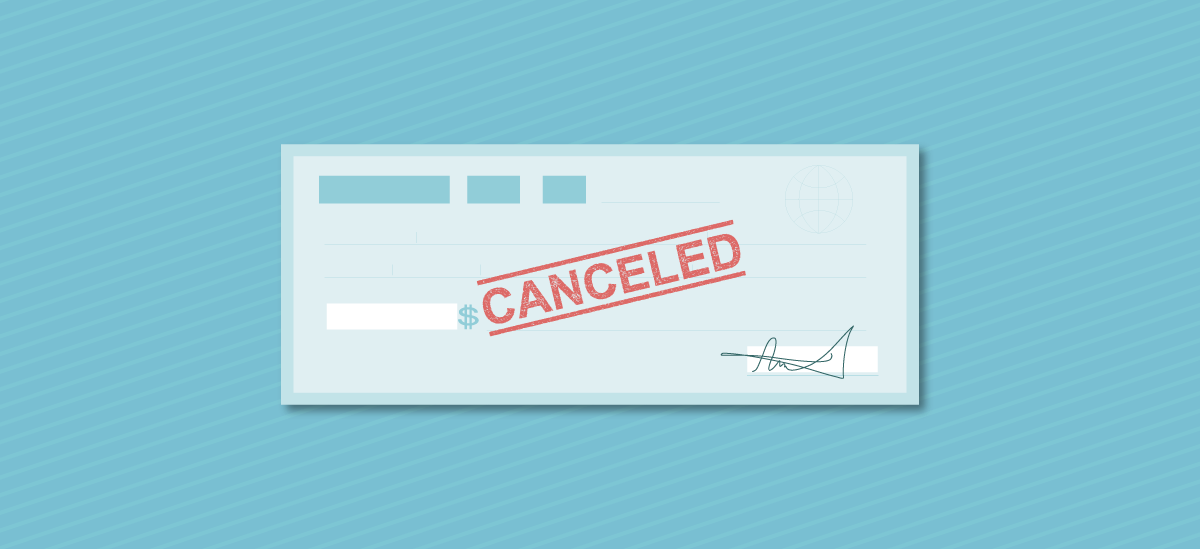
Article Summary
- A canceled check is a check that has been cashed or deposited, making it invalid for re-use.
- Canceled checks are commonly used as proof of payment.
- Digital copies of canceled checks are typically available on online and mobile banking platforms.
- Returned checks cannot be processed due to issues such as insufficient funds.
- A stop payment cancels a check before it's processed by the bank.
As digital banking becomes more common, fewer people rely on paper checks. As a result, many account holders are unfamiliar with terms such as canceled check. However, understanding what a canceled check is and how it works may help individuals better manage their checking accounts. In particular, canceled checks may help you track transactions and stay organized.
What Is a Canceled Check?
A canceled check is a check that has been processed by the bank or financial institution, so it is no longer valid and cannot be reused. Banks cancel a check after the payee has cashed or deposited it. This indicates that the money has been transferred to the recipient and the transaction is complete.
Understanding the Importance of Canceled Checks
Since a canceled check shows that a payment is fully processed, canceled checks are commonly used as proof of payment. This may make them useful for settling disputes and verifying payments.
Canceled checks help account holders keep track of spending and balance their checkbooks. They’re also helpful when maintaining records for tax purposes. For those requesting reimbursements, a canceled check can provide an official record of the payment amount and act as a receipt.
How To Obtain a Canceled Check
Banks used to mail physical copies of canceled checks to account holders along with their monthly bank statements. While many banks no longer offer this service, it’s still easy to access canceled checks. Digital scans of canceled checks are typically found on account holders' online or mobile banking platforms. Some banks also include scanned copies in the monthly statement, providing a consolidated view of the month's transactions.
Account holders can log in and view or download copies of canceled checks at their convenience. Banks may also provide a physical copy upon request, although this service may come with a fee.
Canceled Checks vs. Other Check Types
A check that is canceled, returned, or has a stop payment order is no longer valid for further use. However, there are some key differences between each check type.
Canceled Checks vs. Returned Checks
Checks are canceled after the funds are transferred to the payee. However, when a check is returned, the bank is unable to process the transfer. This typically happens when there are insufficient funds in the account, the account is closed, or there’s an error with the check. Returned checks, also known as bounced checks, often result in fees charged to both parties.
Canceled Checks vs. Stop Payment Orders
Stop payment orders are initiated by the account holder. They occur when the owner of the issuing account asks the bank not to process the check. They’re commonly used when a check contains incorrect information, the payer suspects fraud, or the payer has a dispute with the payee. Unlike canceled checks, stop payment orders are applied before the check is processed. Banks typically charge a fee for this service.
Canceled Checks vs. Voided Checks
An account holder can invalidate a check that has not been cashed by writing the word VOID in large capital letters across the front. This is commonly done when the check writer has made a mistake while writing the check. The terms "voiding" and "canceling" are sometimes used interchangeably. However, a check is only canceled after it is processed by a bank or financial institution.
The Role of Checking in Managing Your Finances
While paper checks are less common, checking accounts are still critical for handling daily expenses for many. Understanding how canceled checks work and how they differ from returned checks and stop-payment orders may help account holders keep track of payments and maintain clear, accurate records.
Frequently Asked Questions
Can you stop a check once it clears?
No, once a check is cleared, the funds are already transferred to the recipient, and it’s not possible to stop payment. To prevent a transfer of funds, the payer must request a stop payment before the bank processes the check.
How long does it take a check to clear?
Checks typically clear within one to two days. However, this may vary depending on factors such as the check amount, where the check was deposited, and the account standing. In some cases, a check may require additional time to fully clear.
Can a bank hold funds after a check clears?
Generally, once a check clears, the funds are made available in the account. However, if there are specific issues, such as potential errors or suspected fraud, the bank may place a temporary hold on the funds after the check has cleared. This typically cannot extend beyond a maximum of seven days from the date of deposit.1







